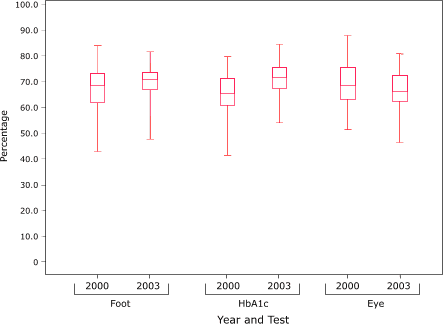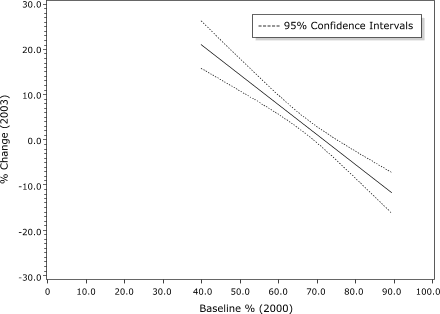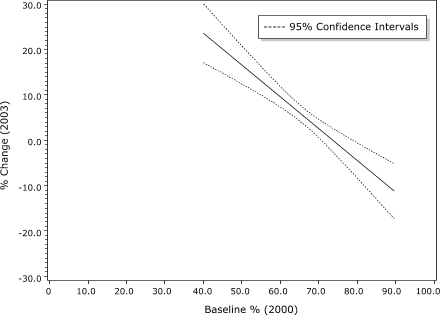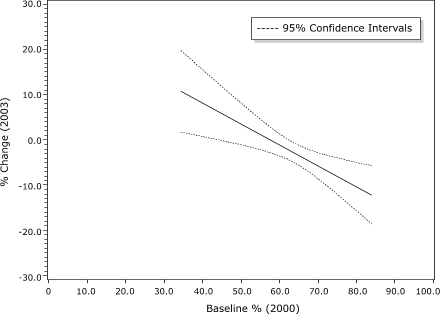

|

|

Volume
3:
No. 1, January 2006
ORIGINAL RESEARCH
Evaluating Progress Toward Healthy People 2010 National Diabetes Objectives
Qaiser Mukhtar, PhD, Leonard Jack, Jr, PhD, MSc, Maurice Martin, PhD, Dara Murphy, MPH, Mark Rivera, PhD
Suggested citation for this article: Mukhtar Q, Jack L Jr, Martin M, Murphy D, Rivera M.
Evaluating progress toward Healthy People 2010 national diabetes objectives. Prev Chronic Dis [serial online] 2006 Jan [date cited]. Available from: URL:
http://www.cdc.gov/pcd/issues/2006/
jan/05_0122.htm.
PEER REVIEWED
Abstract
Introduction
In 1999, the National Diabetes Prevention and Control Program at the Centers
for Disease Control and Prevention and its 59 Diabetes Prevention and Control
Programs adopted five Healthy People 2010 objectives. These objectives aim to improve the rates of preventive care services among people with diabetes
and
include annual foot examinations, hemoglobin A1c tests, and annual dilated eye examinations. This paper examines progress toward meeting these three objectives.
Methods
Questions from the diabetes module of the Behavioral Risk Factor Surveillance System (BRFSS) were used to evaluate changes in age-adjusted rates for
annual foot examinations, hemoglobin A1c tests, and
annual dilated eye examinations of 44 jurisdictions between 2000 and 2003. Questions from the diabetes module were also used to compare
percentage rates of 47 jurisdictions in 2003 with Healthy People 2010
percentage targets.
Results
From 2000 to 2003, for the 44 jurisdictions, the aggregate, age-adjusted rate of
annual foot examinations increased from 63.7% to 69.3% (P < .001); the rate of self-reported hemoglobin A1c tests increased
from 68.3% to 69.5% (P = .35); and the rate of annual dilated eye examinations decreased
from 67.7% to 65.2% (P = .05). In 2003, 20 of 47 jurisdictions met the Healthy People 2010
target for foot or eye examinations, and all 47 jurisdictions met the target for
hemoglobin A1c tests. An inverse association was found between baseline rates in
2000 and the magnitude of change from 2000 to 2003 for all three national diabetes objectives.
Conclusion
The National Diabetes Prevention and Control Program should consider adopting additional Healthy People 2010 objectives. Baseline rates should be considered in 1) selecting objectives, 2) setting percentage targets, and 3) evaluating current or future objectives. Program-related information should be linked with traditional data sources such as BRFSS so that we can understand the
role of environmental factors and evaluate progress of jurisdictions toward national diabetes objectives.
Back to top
Introduction
Diabetes and its associated burden are continuously evolving (1). More than 18 million adults in the United States have diabetes (2). People with diabetes are at increased risk of developing complications such as blindness, lower extremity amputations, end-stage renal disease, and cardiovascular disease (2). Although recommended preventive care services can prevent or delay the development of
these serious health complications (3-6), the proportion of adults with diabetes who report receiving preventive care services is less than what we hope for (7-8).
Increasing the rates of preventive care services among people with diabetes is an objective of Healthy People 2010 (HP2010),
a program established by the U.S. Department of Health and Human Services (9). In 1999, the National Diabetes Prevention and Control Program (NDPCP),
established by the Centers for Disease Control and Prevention (CDC), adopted
three of the 17 HP2010 diabetes objectives and two of the HP2010
immunization objectives. The five
objectives adopted include percentage targets for annual hemoglobin A1c (HbA1c)
tests, annual dilated eye examinations, annual foot examinations, and influenza and pneumococcal vaccinations
(Table 1). Hereafter, we refer to these objectives as
national diabetes objectives. This report focuses on the following three national diabetes objectives
and their percentage targets for the U.S. population with diabetes: 1) 50% receive an HbA1c measurement at
least twice each year, 2) 75% receive an annual dilated eye examination, and 3)
75% receive an annual foot examination. Implementation strategies used to help achieve these objectives are described elsewhere (10).
The NDPCP supports a Diabetes Prevention and Control Program (DPCP) in each of
the 50 U.S. states,
8 territories, and the District of Columbia (10), or jurisdictions. The
59 DPCPs strive to reduce the preventable burden of diabetes and its associated
complications in their jurisdictions by building collaborations and working
closely with their partners. These partners include managed care organizations,
policy makers, and the American Diabetes Association and its local affiliates
(10). When the NDPCP adopted the five national diabetes objectives, it asked the
DPCPs to increase target percentage rates for each objective within their
jurisdiction. The NDPCP itself did not set these targets because it recognized
that DPCPs vary in capacity and funding.
Back to top
Methods
To evaluate progress toward national diabetes objectives, we analyzed data on diabetes preventive care services from the Behavioral Risk Factor Surveillance System (BRFSS). The BRFSS is a state-based, randomized telephone survey of the noninstitutionalized U.S. population aged 18 years and older. BRFSS surveys are conducted in
each of 50 U.S. states, the District of Columbia, and three U.S. territories
(the U.S. Virgin Islands, Puerto Rico, and Guam). The optional diabetes module contains 12 diabetes-specific questions; these questions are asked of people who identify themselves as having diabetes
(11). People with diabetes were defined as those who answered yes to the core BRFSS question, “Has a doctor ever told you that you have diabetes?” Women who were told that they had diabetes only during
pregnancy were excluded from the analysis. Individuals who refused to answer or had missing or unknown values for any variable were also excluded from the analysis. In addition, data from Guam and the U.S. Virgin Islands were excluded from the analysis.
We analyzed responses to three preventive care practice questions from the diabetes module: 1) “When was the last time you had an eye examination in which the pupils were dilated?" 2)
“About how many times in the last year has a health professional checked your feet for any sores or irritations?” and 3) “A test for hemoglobin ‘A one C’ measures the average level of blood
sugar over the past 3 months. About how many times in the past 12 months has a doctor, nurse, or other health professional checked you for hemoglobin ‘A one C’?” People with diabetes who reported receipt of at least one dilated eye examination,
one foot examination, or two or more HbA1c tests in the past year were defined as having received these preventive care services.
Forty-four jurisdictions used the diabetes module in both 2000 and 2003 (10); 47 used the diabetes module in 2003. First, we calculated the percentage of people with diabetes who reported receipt of the three selected preventive care services for the 44 jurisdictions. Second, we compared the percentages for 47 jurisdictions that used the module in 2003 with HP2010
percentage
targets.
All rates were age-adjusted to the 2000 U.S. standard population. T-tests were used to determine whether differences between 2000 and 2003 were statistically significant. No correction was made for multiple testing of the three outcomes. We used simple linear regression to assess the association between baseline rates in 2000 and the magnitude of change between 2000 and 2003 rates. Analyses were
conducted using SAS 9.1 (SAS Institute Inc, Cary, NC) and SUDAAN 9.0 (RTI International, Research Triangle Park, NC).
Back to top
Results
From 2000 to 2003, the aggregate age-adjusted rate for foot examinations
increased from 63.7% to 69.3% (Table 2);
the rate for HbA1c tests increased from 68.3% to
69.5% (Table 3), and the rate
for dilated eye examinations decreased from 67.7% to 65.2%(Table
4). Only the increase in
the rate for foot examinations was statistically significant (P < .001).
Age-adjusted rates for foot examinations increased in 26 (59%) jurisdictions
(Table 2), rates for HbA1c tests increased in 33 (75%) jurisdictions (Table 3), and rates for dilated eye examinations increased in 15
(34%) jurisdictions (Table 4). Compared with interquartile ranges for all three
tests in 2000, interquartile ranges are smaller in 2003 (Figure 1). However, overall ranges are large for both 2000 and 2003. In 2003,
rates for foot examinations ranged from 47.0% to 82.4%, rates for HbA1c tests ranged from 53.6% to 85.5%,
and rates for eye examinations ranged from 45.8% to 81.6% (Figure 1). These ranges are similar to ranges for 2000. The ranges for 2000 were 42.1% to 85.1% for foot examinations, 40.5% to 80.5% for HbA1c tests,
and 51.0% to 89.0% for eye examinations (Figure 1).

Figure 1. Percentage rates for annual foot examination, two or
more annual hemoglobin A1c (HbA1c) tests, and annual dilated eye examination for 47 jurisdictions, Behavioral Risk Factor Surveillance System, 2000 and 2003.
Overall range, interquartile range, and median are indicated. [A
tabular version of this graph is also available.]
Compared with HP2010 targets, the 2003 data from 47 jurisdictions showed that 11
(23%) jurisdictions met the 75% target for foot examination (Table 2), nine (19%) met the 75%
target for dilated eye examination (Table 4), and all jurisdictions met the 50% target of at least two HbA1c tests per year
(Table 3).The following five states were at or above the HP2010 targets
for all three objectives: Delaware, Hawaii, Massachusetts, Minnesota, and New
Hampshire (Tables 2-4).
An inverse association was found between the baseline rate in 2000 and the magnitude of change between 2000 and 2003. Jurisdictions that had relatively low baseline rates in 2000 were more likely to show an increase in 2003 or to maintain their baseline rates. Jurisdictions with relatively high baseline rates in 2000 were more likely to show a decrease in 2003.
For every unit increase in the baseline percentage rate in 2000, the predicted
2003 rate decreased as follows: for foot examination by 0.66% (Figure 2; F value
= 52.4; P < .001); for HbA1c tests by 0.69% (Figure 3; F value = 34.7; P
< .001), and for eye examination by 0.46% (Figure 4; F value = 9.7; P
= .003).

Figure 2. Regression of change in 2003 rates for annual foot examinations on 2000 baseline rates for 44 jurisdictions, Behavioral Risk Factor Surveillance System
data.

Figure 3. Regression of change in 2003 rates for
two or more annual hemoglobin A1c tests on 2000 baseline rates for 44 jurisdictions, Behavioral Risk Factor Surveillance System
data.

Figure 4. Regression of change in 2003 rates for annual dilated eye examinations on 2000 baseline rates for 44 jurisdictions, Behavioral Risk Factor Surveillance System data.
Back to top
Discussion
Factors affecting the rate of receipt of preventive care services are numerous and include an individual’s knowledge about the importance of
obtaining the recommended tests and examinations, access to diabetes care, availability of health insurance, extent of health insurance coverage for
diabetes care services, and the adherence of health care providers to recommended diabetes care guidelines
(10).
Our findings show an inverse association between the baseline rates of the three selected preventive care services and the magnitude of change in rates from 2000 to 2003. This negative association may result from the statistical phenomenon known as regression toward the mean. In regression toward the mean, rates that are initially high or initially low eventually move toward the average
because the initial performance occurred by chance (e.g., as a result of measurement error) or was caused by a factor unrelated to the intervention (12). A ceiling effect could also explain the negative association. With a ceiling effect, the initial impact of an intervention on rates may be large, but once rates reach a certain threshold, the intervention does not yield the same rate
increases; rates may then reach a plateau or even decrease. The negative association between baseline rates and magnitude in change should be studied further.
The inverse association between baseline rates in 2000 and the predicted
rates for 2003 confirms that it would not be appropriate for the NDPCP to
evaluate the performance of a jurisdiction exclusively on the basis of rate
increases or decreases. Moreover, 20 (42%) of 47 jurisdictions have already reached the HP2010
target of 75%
for foot or eye examinations, and an additional 27 (57%) jurisdictions have rates between 70% and 75%.
These jurisdictions are likely to experience a ceiling effect. Additionally,
other revisions to the HP2010 targets are being considered. The proposed targets are as follows: 91% of people with diagnosed diabetes receive an annual foot examination, 76% of people with
diagnosed diabetes receive an annual dilated eye examination, and 65% of people with diagnosed diabetes receive at least two HbA1c tests
annually (13). In 2003, the highest rate for foot examinations was 82.5%; jurisdictions are likely to struggle
to reach the 91% target.
Regardless of whether new HP2010 revisions are adopted, the NDPCP
should consider setting multilevel objectives instead of expecting all jurisdictions to show continuous rate increases. For example, jurisdictions below or at certain rates could aim to increase rates while jurisdictions with high rates (e.g., above 75%) could strive to maintain these rates and adopt new
objectives. The idea of setting multilevel objectives is supported by evidence of the disparity in rates
for national diabetes objectives among jurisdictions (Figure 1).
In addition to considering multilevel targets, the NDPCP should consider moving from the process-focused objective of increasing the percentage of people with diabetes who receive at least two HbA1c tests to an outcome-focused objective such as reducing the percentage of people with poor glycemic control assessed through measuring HbA1c values. Currently, all 47 jurisdictions analyzed in this
study have achieved the HP2010 objective of 50% for at least two HbA1c tests, and 32
(68%) jurisdictions have achieved a rate of more than 70% (Table
3). Strong evidence supports a significant correlation between glycemic control and microvascular and cardiovascular disease risk and mortality rates
(5). For example, in the U.K. Prospective Diabetes Study, each 1% reduction in HbA1c levels was
associated with a 37% reduction in risk for diabetic peripheral neuropathy, diabetic retinopathy, and diabetic nephropathy, conditions responsible for lower-extremity amputation, blindness, and end-stage renal disease (5).
State-level data on HbA1c values are available through the Health Plan Employer Data and Information Set (HEDIS).
Currently, few jurisdictions use this data source; possible barriers to use
include lack of access to the data, cost, not having an epidemiologist on staff,
and complexity of data analysis (14).
Findings from this study have important implications for the NDPCP and its partners, especially as the CDC moves to align its priorities toward health promotion and prevention of disease, injury, and disability outcomes through improving quality of health by stages of life (15). The NDPCP and its partners will have opportunities to revise and add new national diabetes objectives to reduce the
preventable burden of diabetes. Jurisdictions that are close to meeting or have already met the HP2010 objectives will be good candidates to pioneer new objectives.
New national diabetes objectives could be
selected from existing HP2010 diabetes objectives, or entirely new
objectives could be developed and adopted.
Program-related information should be linked with traditional data sources such as
the BRFSS so that we can understand the role of environmental factors as we
evaluate the progress of jurisdictions toward national diabetes objectives. For program evaluation, it is imperative to understand why some jurisdictions
perform better than others. It is especially important to
examine jurisdictions that had high baseline rates in 2000 and showed rate increases in 2003. A range of environmental factors are likely to influence jurisdiction performance. These factors include budget, resources, leadership, partnerships, public health infrastructure, policies, and specific interventions. We need to understand how the adoption and sustainability
of clinical and community-based interventions are effective in increasing preventive care services. To evaluate the impact of the effort of a jurisdiction on national diabetes objectives, we must identify and
possibly modify existing data sources that contain
program-related information.
For several years, the NDPCP has been building capacity to capture program-related information in
its own electronic management information system (MIS). The MIS is a Web-based
system designed to facilitate the collection and sharing of program-related
information among state-based diabetes prevention and control programs and the
NDPCP. The NDPCP is refining the MIS to link it with traditional data sources such as the BRFSS.
When it is completed, the MIS will enable NDPCP to measure the association between the effort of each jurisdiction and its impact on rates of preventive care services. Enhancing the MIS will
allow the NDPCP and jurisdictions to gain a better understanding of the influence of environmental factors.
Our findings are subject to several limitations. The BRFSS collects data through telephone surveys that exclude institutionalized people (e.g., nursing home residents) and people without telephones. The exclusion of these populations, particularly people without telephones, could result in overestimation of people receiving the three preventive care services, assuming that such people are
likely to be less educated, poor, and therefore less likely to receive preventive care (16,17). The BRFSS data are also self-reported and subject to recall bias.
Additionally, the BRFSS data reflect statewide changes; they do not reflect changes that are taking place in special populations. Additional data sources such as Medicare and Medicaid records are needed for a more robust analysis of progress in achieving national diabetes objectives for such populations. Finally, comparing single-year data (2000 with 2003) could be a possible limitation, but
if we had pooled years (i.e., 2000 and 2001 compared with 2002 and 2003), we would not have had a sufficient time lag for comparison.
Back to top
Conclusion
The progress of jurisdictions toward achieving national diabetes objectives cannot be evaluated based on simple increases or decreases in their rates of
preventive care services. Baseline rates should be considered in evaluating their progress
toward achieving national diabetes objectives. There is a need for developing and adopting new objectives, especially for the jurisdictions that have already met or are close to reaching
HP2010 objectives. Gaining better understanding of the environmental factors that affect each jurisdiction — such as budget, policy, and health care coverage — is critical for appreciating and evaluating progress. To evaluate the impact of the effort of a jurisdiction on rates of national diabetes objectives, we must identify and modify existing data sources (e.g., the MIS)
that contain program-related information. Linking this system with traditional data sets such as the BRFSS could help identify and quantify the underlying factors vital to progress toward national diabetes objectives.
Back to top
Acknowledgments
The authors thank Liping Pan, health care analyst with the Epidemiology and Statistics Branch, Division
of Diabetes Translation, CDC, for her assistance in preparing this manuscript.
Back to top
Author Information
Corresponding Author: Qaiser Mukhtar, PhD, Epidemiologist, Applied Behavioral Research, Epidemiology, Surveillance, and Program Evaluation Team, Program Development Branch,
Division of Diabetes Translation, Centers for Disease Control and Prevention; 4770 Buford Hwy
NE, Mail
Stop K-10, Atlanta, GA 30341. Telephone: 770-488-5505. E-mail:
qam2@cdc.gov.
Author Affiliations: Leonard Jack, PhD, MSc, Team Lead, Maurice Martin, PhD,
Research and Evaluation Scientist, Mark Rivera, PhD, Research and Evaluation
Scientist, Applied Behavioral Research, Epidemiology, Surveillance, and Program
Evaluation, Program Development Branch, Division of Diabetes Translation,
Centers for Disease Control and Prevention, Atlanta, Ga; Dara Murphy, MPH,
Branch Chief, Division of Diabetes Translation, Centers for Disease Control and
Prevention, Atlanta, Ga.
Back to top
References
- Engelgau MM, Geiss LS, Saaddine JB, Boyle JP, Benjamine SM, Gregg EW, et al.
The evolving diabetes burden in the United States. Ann Intern Med 2004;140:945-50
- Harris MI.
Diabetes in America: epidemiology and scope of the problem.
Diabetes Care 1998;21(Suppl 3):C11-14.
- The Diabetes Control and Complications Trial Research Group.
The effect of intensive treatment of diabetes on the development and progression of long-term complications in insulin-dependent diabetes mellitus. N Engl J Med 1993;329:977-86.
- Litzelman DK, Slemenda CW, Langefeld CD, Hays LM, Welch MA, Bild DE, et al.
Reduction of lower extremity clinical abnormalities in patients with non-insulin dependent diabetes mellitus.
A randomized, controlled trial. Ann Intern Med 1993;119:36-41.
- Stratton IM, Adler AI, Neil HA, Matthews DR, Manley SE, Cull CA, et al.
Association of glycemia with macrovascular and microvascular complications of type 2 diabetes (UKPDS 35):
prospective observational study. BMJ 2000;321:405-12
- American Diabetes Association. Clinical practice recommendations. Diabetes Care 2005;28:Suppl 1:S1-79.
- Centers for Disease Control and Prevention.
Levels of diabetes-related preventive-care practices — United States, 1997–1999. MMWR
Morb Mortal Wkly Rep 2000;49:954-8.
- Centers for Disease Control and Prevention.
Influenza and pneumococcal vaccination rates among persons with diabetes mellitus — United States, 1997. MMWR
Morb Mortal Wkly Rep 1999;48:961-7.
- U.S. Department of Health and Human Services. Healthy people 2010. 2nd edition.
With understanding and improving health and objectives for improving health. Washington
(DC): U.S. Government Printing Office; 2000.
- Safran MA, Mukhtar Q, Murphy DL.
Implementing program evaluation and accountability for population health: progress of a national diabetes control effort. J Public Health Manag Pract 2003;9(1):58-65.
- Mukhtar Q, Murphy DL, Mitchell PL.
Use of data from the Behavioral Risk Factor Surveillance System optional diabetes module by states.
J Public Health Manag Pract 2003 Nov;9(6S):S52-S55.
- Barnett AG, van der Pols JC, Dobson AJ.
Regression to the mean: what it is and how to deal with it. Int J Epidemiol 2000 34(1):215-20.
- U.S. Department of Health and Human Services. Healthy People 2010 Midcourse
Review [Internet]. Washington (DC): Office and Disease Prevention and Health
Promotion. Available from: URL: www.healthypeople.gov/data/midcourse/comments/ faobjective.asp?id=5.
- Desai J, Geiss L, Mukhtar Q, Harwell T, Benjamin S, Bell R, et al.
Public health surveillance of diabetes in the United States. J Public Health Manag Pract 2003;Suppl:S44-51.
- Centers for Disease Control and Prevention. Futures initiative update: goals management
[Internet]. Atlanta (GA): U.S. Department of Health and Human Services, Centers
for Disease Control and Prevention. Available from:
URL: http://www.cdc.gov/futures/update.htm.
- Centers for Disease Control and Prevention.
Preventive-care practices among persons with diabetes — United States, 1995 and 2001. MMWR
Morb Mortal Wkly Rep 2002;51:965-9.
- Saaddine JB, Engelgau MM, Beckles GL, Gregg EW, Thompson TJ, Narayan KM.
A diabetes report card for the United States: quality of care in the 1990s. Ann Intern Med 2002;136:565-74.
Back to top
|
|
